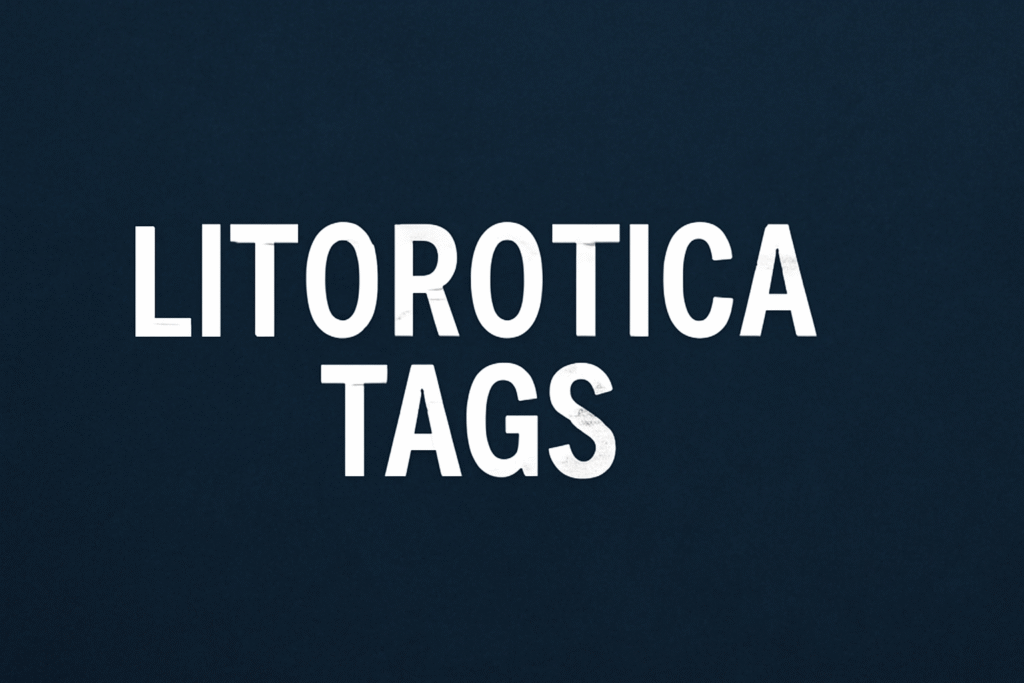In the ever-evolving world of online content, tags are an essential component for improving discoverability and enhancing user engagement. One such tag gaining prominence is Litorotica tags, which has become increasingly popular among creators and consumers of niche content. This article delves into the significance of Litorotica tags, how they work, and the best practices for optimizing your content using these tags.
What Are Litorotica Tags?
Litorotica tags are descriptive keywords used to categorize and organize content, typically in adult-themed writing or media. These tags help users find specific content that aligns with their interests, thus improving the chances of content visibility. By employing relevant tags, creators can make their work more accessible to a wider audience while ensuring that users can find exactly what they’re looking for.
In the context of Litorotica, these tags often revolve around themes like erotic fiction, fetishes, and specific character dynamics, allowing users to easily navigate various sub-genres and preferences.
Why Are Litorotica Tags Important?
Tags play a critical role in optimizing content. When used effectively, they serve as both a navigational tool and a search engine optimization (SEO) tactic. Here are some reasons why Litorotica tags are essential for creators and users alike:
- Increased Discoverability: Properly tagged content is more likely to appear in search results, making it easier for users to find your material.
- Better User Experience: Tags help users filter through content to find exactly what interests them, leading to a more satisfying browsing experience.
- Engagement and Community Building: Tags facilitate discussions and community building within niche content spaces, as users can explore related works easily.
- SEO Benefits: Using Litorotica tags effectively enhances the SEO ranking of your content, increasing the likelihood of appearing in search results related to specific topics or themes.
Best Practices for Using Litorotica Tags
Optimizing your content with the right tags is an art form that can significantly boost your content’s performance. Below are some best practices for using Litorotica tags effectively:
1. Be Specific and Descriptive
To maximize the impact of your tags, ensure that they are as specific as possible. For example, instead of using broad terms like “erotic,” use Litorotica tags that describe the content in more detail, such as “sensual romance” or “lesbian domination.” Specific tags help narrow down the search and ensure that your content is found by those interested in that particular subgenre.
2. Use a Combination of General and Niche Tags
While it’s essential to include niche-specific tags to target a particular audience, incorporating more general tags can also help increase visibility. This approach creates a balance, allowing your content to reach both niche and broader audiences.
3. Stay Relevant to the Content
It’s crucial to remain truthful and relevant when tagging your content. Using misleading tags in an attempt to gain more clicks can backfire, as users may leave quickly if the content doesn’t match their expectations. Always ensure your tags accurately reflect the content.
4. Monitor Trends and Popular Tags
Trends are constantly evolving in the Litorotica space, so staying updated on trending tags is essential. Regularly monitoring popular tags and using them appropriately can help ensure that your content remains relevant and discoverable to a wider audience.
5. Don’t Overload with Tags
While it might be tempting to use as many tags as possible, it’s important not to overdo it. Focus on using tags that are truly relevant to your content. Using too many tags can make your content appear spammy and decrease its credibility.
How Litorotica Tags Enhance Content Interaction
In addition to improving discoverability and engagement, Litorotica tags contribute to deeper user interaction. By using tags, you can create a community around specific themes and preferences. For example, tags related to BDSM, roleplay, or specific fetishes allow users to explore and discuss content within these subcategories.
Building a Community
When users consistently find content that aligns with their interests through the use of Litorotica tags, they are more likely to return to your platform. This sense of community fosters user loyalty and long-term engagement.
Facilitating Collaboration
Tags also make it easier for creators to collaborate. By tagging works with specific themes, other creators can quickly identify pieces that may align with their interests or project goals, leading to more collaborative opportunities within niche spaces.
The Future of Litorotica Tags and Content Optimization
As the digital landscape evolves, so too does the role of tags in content optimization. The continued use of Litorotica tags is expected to grow, with more platforms adopting tagging systems to improve user experience and content discoverability.
The future holds even more advanced tools for creators to enhance their SEO and user engagement strategies. In the coming years, we might see increased integration of AI-driven algorithms that suggest the most relevant tags based on user preferences and behaviors. These tools will likely make the tagging process even more streamlined, allowing for quicker and more efficient content optimization.
Conclusion
To conclude, Litorotica tags are an invaluable tool for creators looking to optimize their content for increased visibility, engagement, and discoverability. By using specific, relevant, and trending tags, creators can ensure that their content reaches the right audience while fostering community and interaction. As the digital world continues to evolve, the importance of effective tagging will only grow, making it crucial for content creators to stay ahead of the curve.
Frequently Asked Questions (FAQ)
1. How do Litorotica tags help in SEO?
Litorotica tags help in SEO by improving content discoverability, allowing it to rank higher in search engine results. The right tags ensure that your content reaches the audience searching for similar themes.
2. Can I use multiple tags for the same piece of content?
Yes, you can use multiple tags, but it’s essential to ensure they are relevant and not overused. A mix of general and niche-specific tags is often most effective.
3. Are Litorotica tags only for adult content?
While Litorotica tags are most commonly used for adult-themed content, they can also be applied to any type of content that focuses on erotic or sensual themes.
4. How can I keep up with trending tags?
You can stay updated by following popular platforms, social media groups, and websites that cater to Litorotica content. Regularly check what tags are being used in trending content.
5. Should I use Litorotica tags for all my content?
Only use Litorotica tags if they accurately reflect the content. Misleading tags can hurt your content’s credibility and cause a negative user experience.



